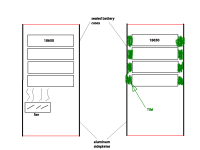Overclocker
10 kW

we've all seen the typical ebike battery pack. some are even encased in (insulating) foam. heat gets trapped inside. a typical hailong pack doesn't have any effective heat path to the outside air.
on the other extreme there's Tesla's liquid cooling. not really viable for ebike packs.
so here are two SEALED battery boxes. both with aluminum side covers. the objective is to transfer as much heat from the cells to the side plates.
the LEFT box simply circulates the inside air. flows air between the cells which are slightly separated.
the RIGHT box uses soft TIMs (thermal interface material) which have horrendous bulk thermal conductivity :lol:
the left box is going to work better, right?


